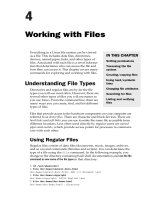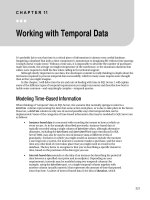Lesson Working with Oracle
Bạn đang xem bản rút gọn của tài liệu. Xem và tải ngay bản đầy đủ của tài liệu tại đây (672.86 KB, 26 trang )
������������������������������������������������������������������������������������������������������������������������������������������������������������������������������������������������������������������������������������������������������������������������������������������������������������������������������������������������������������������������������������������������������������������������������������������������������������������������������������������������������������������������������������������������������������������������������������������������������������������������������������������������������������������������������������������������������������������������������������������������������������������������������������������������������������������������������������������������������������������������������������������������������������������������������������������������������������������������������������������������������������������������������������������������������������������������������������������������������������������������������������������������������������������������������������������������������������������������������������������������������������������������������������������������������������������������������������������������������������������������������������������������������������������������������������������������������������������������������������������������������������������������������������������������������������������������������������������������������������������������������������������������������������������������������������������������������������������������������������������������������������������������������������������������������������������������������������������������������������������������������������������������������������������������������������������������������������������������������������������������������������������������������������������������������������������������������������������������������������������������������������������������������������������������������������������������������������������������������������������������������������������������������������������������������������������������������������������������������������������������������������������������������������������������������������������������������������������������������������������������������������������������������������������������������������������������������������������������������������������������������������������������������������������������������������������������������������������������������������������������������������������������������������������������������������������������������������������������������������������������������������������������������������������������������������������������������������������������������������������������������������������������������������������������������������������������������������������������������������������������������������������������������������������������������������������������������������������������������������������������������������������������������������������������������������������������������������������������������������������������������������������������������������������������������������������������������������������������������������������������������������������������������������������������������������������������������������������������������������������������������������������������������������������������������������������������������������������������������������������������������������������������������������������������������������������������������������������������������������������������������������������������������������������������������������������������������������������������������������������������������������������������������������������������������������������������������������������������������������������������������������������������������������������������������������������������������������������������������������������������������������������������������������������������������������������������������������������������������������������������������������������������������������������������������������������������������������������������������������������������������������������������������������������������������������������������������������������������������������������������������������������������������������������������������������������������������������������������������������������������������������������������������������������������������������������������������������������������������������������������������������������������������������������������������������������������������������������������������������������������������������������������������������������������������������������������������������������������������������������������������������������������������������������������������������������������������������������������������������������������������������������������������������������������������������������������������������������������������������������������������������������������������������������������������������������������������������������������������������������������������������������������������������������������������������������������������������������������������������������������������������������������������������������������������������������������������������������������������������������������������������������������������������������������������������������������������������������������������������������������������������������������������������������������������������������������������������������������������������������������������������������������������������������������������������������������������������������������������������������������������������������������������������������������������������������������������������������������������������������������������������������������������������������������������������������������������������������������������������������������������������������������������������������������������������������������������������������������������������������������������������������������������������������������������������������������������������������������������������������������������������������������������������������������������������������������������������������������������������������������������������������������������������������������������������������������������������������������������������������������������������������������������������������������������������������������������������������������������������������������������������������������������������������������������������������������������������������������������������������������������������������������������������������������������������������������������������������������������������������������������������������������������������������������������������������������������������������������������������������������������������������������������������������������������������������������������������������������������������������������������������������������������������������������������������������������������������������������������������������������������������������������������������������������������������������������������������������������������������������������������������������������������������������������������������������������������������������������������������������������������������������������������������������������������������������������������������������������������������������������������������������������������������������������������������������������������������������������������������������������������������������������������������������������������������������������������������������������������������������������������������������������������������������������������������������������������������������������������������������������������������������������������������������������������������������������������������������������������������������������������������������������������������������������������������������������������������������������������������������������������������������������������������������������������������������������������������������������������������������������������������������������������������������������������������������������������������������������������������������������������������������������������������������������������������������������������������������������������������������������������������������������������������������������������������������������������������������������������������������������������������������������������������������������������������������������������������������������������������������������������������������������������������������������������������������������������������������������������������������������������������������������������������������������������������������������������������������������������������������������������������������������������������������������������������������������������������������������������������������������������������������������������������������������������������������������������������������������������������������������������������������������������������������������������������������������������������������������������������������������������������������������������������������������������������������������������������������������������������������������������������������������������������������������������������������������������������������������������������������������������������������������������������������������������������������������������������������������������������������������������������������������������������������������������������������������������������������������������������������������������������������������������������������������������������������������������������������������������������������������������������������������������������������������������������������������������������������������������������������������������������������������������������������������������������������������������������������������������������������������������������������������������������������������������������������������������������������������������������������������������������������������������������������������������������������������������������������������������������������������������������������������������������������������������������������������������������������������������������������������������������������������������������������������������������������������������������������������������������������������������������������������������������������������������������������������������������������������������������������������������������������������������������������������������������������������������������������������������������������������������������������������������������������������������������������������������������������������������������������������������������������������������������������������������������������������������������������������������������������������������������������������������������������������������������������������������������������������������������������������������������������������������������������������������������������������������������������������������������������������������������������������������������������������������������������������������������������������������������������������������������������������������������������������������������������������������������������������������������������������������������������������������������������������������������������������������������������������������������������������������������������������������������������������������������������������������������������������������������������������������������������������������������������������������������������������������������������������������������������������������������������������������������������������������������������������������������������������������������������������������������������������������������������������statements in SQL*Plus.
• Refer to SQL*Plus User’s Guide for Documentation
• Enter the following:
SQL> set property_name new_value
• Example of a set of statements to customize SQL*Plus:
SQL>
SQL>
SQL>
SQL>
SQL>
set
set
set
set
set
linesize 132
pagesize 100
echo on
long 4000
autocommit off
Generating Output
To generate output to a file, enter:
SQL> spool path_to_file
• This writes everything into the file at given path.
– Use the following command to see what is being
written to the file:
set echo on
• If the file has no extension, .lst is created.
• It overwrites the existing file.
To buffer writes and stop spooling of output, enter
SQL> spool off
Unix Overview
21
Customizing Output
To customize output, enter:
SQL> column column_name format format
This changes the default length and format of column output.
SQL> select bu_nam from cz_bus_unit where bu_unit = 0;
BU_NAM
---------------------------------------SYSTEM
SQL> column bu_nam format a10
SQL> /
BU_NAM
---------SYSTEM
Working with Oracle
Basic SQL Commands
Unix Overview
22
Basic Commands
Command description
SQL Command
Show user
show user;
List tables in current
schema
select table_name from user_tables;
List tables current user select table_name from all_tables
has access to
See table description
desc <tablename>;
Repeat last command
/
Basic Commands
Command description
SQL Command
Set number lines per
page to n
Set pagesize n
(no semicolon used)
Set number columns
to n
Set linesize n
(no semicolon used)
Count the rows of a
table
select count(*) from <tablename>;
List the top n rows of a select * from
table in order
(select * from <tablename>
order by <columnname>)
where rownum <= n;
Unix Overview
23
Basic Commands
Command description
SQL Command
Request all information
from a table
select *
from <tablename>;
Request a column of
select <columnname>
information from a table from <tablename>;
Request information
based on a condition
select <columnname>
from <tablename>
where <condition>;
Sort the output
select <columnname>
from <tablename>
where <condition on column>
order by <sorting column>;
Basic Commands
Command description
SQL Command
Insert information into a insert into <tablename>
table
values ( <complete list of values> );
Update a column in
every row
update <tablename>
set <column name> = <value>;
Update a column based update <tablename>
on a condition
set <column name> = <value>
where <codition>;
Commit any changes to commit;
the database before
exiting
Unix Overview
24
Basic Commands
Command description
SQL Command
You can use aliases to
abbreviate table names
in commands
select tn.<columnname>
from <tablename> tn
where tn.<columname> = <value>;
You can use compound where <columnname1> = <value1>
conditions in the
and <columnname2> = <value2>;
WHERE clause
Accept a table name
from the keyboard and
then use in another
command. These are
separate commands
accept tabl
prompt ‘Enter table name
’;
select * from &tabl;
Module Summary
At the end of this module, you have learned:
•
•
•
•
•
•
•
•
Unix Overview
Basic commands of korn Shell
User permission and file permission in Unix
Basic functions in Unix
Useful commands in Unix
Vi editor commands
Database concepts
SQL commands
Use of SQL*Plus
25
Unix Overview
26









